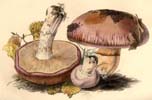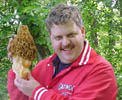Heinrich Klebahn (1859 - 1942)
Back to Author Index
Biography
Sources
Selected publications
Biography
teaches primary school while studying in a private school in Bremen
1881 studies natural science in the university at Jena, also for a brief period at Berlin
1884 earns PhD in Jena; participates in a seminar for scholars in German, mathematics and natural science
1894 runs a teachers' seminar in Hamburg
1899 appointed scientific assistant to the botanical garden in Hamburg, remaining such at the Institute for General Botany after its split from the university of Hamburg
1921 named honorary professor and lecturer in cryptogams and soil biology at the Institute
It's actually rather difficult to translate the name Institut für Allgemeine Botanik. The middle word really means something like "united", or "universal". "General botany" sounded less pompous and (in English) more normal, although (given that it's a German institution in the 20s) less pompous may not be correct.
Klebahn's main scientific contributions are a series of experiments on rusts. He also wrote up the rusts for several of the big compilation projects of his day, and ended up doing work on the Ascomycetes.
Back to top
Sources
Heinrich Dörfelt & Heike Heklau (1998) Die Geschichte der Mykologie
(Die Geschichte der Mykologie)
Back to top
Selected Publications
Heinrich Klebahn (1904) Die wirtwechselnden Rostpilze (The heteroecious rusts)
Heinrich Klebahn (1909) Krankheiten des Flieders (Diseases of lilacs)The word flieder can also refer to elders.
Heinrich Klebahn (1914) "Beiträge zur Kenntnis der Fungi Imperfecti: III. Zur Kritik einiger Pestalozzia-Arten" (Contributions towards understanding the Fungi Imperfecti Towards a critique of some species of Pestalozzia) in Mycologisches Centralblatt 4:1 pp. 1 - 19
Heinrich Klebahn (1918) Haupt- und Nebenfruchtformen der Askomyzeten: Erster Teil: Eigene Untersuchungen (Primary and secondary fruiting-body forms in the Ascomycetes Part one: some researches) 395 pp.
Back to top











